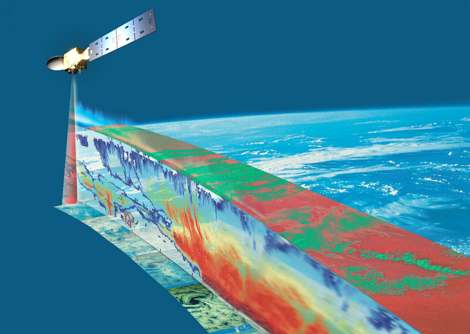
PR – The European Space Agency and Astrium GmbH have today signed a contract worth €263 million to provide the EarthCARE satellite, the sixth Earth Explorer mission of ESA’s Living Planet Programme. As prime contractor, Astrium GmbH is responsible for the satellite’s design, development and integration.
 The contract was signed today in Berlin on the occasion of the International Aerospace Exhibition (ILA) by Volker Liebig, ESA’s Director of Earth Observation, Evert Dudok, CEO of Astrium Satellites and Uwe Minne, Director of Earth Observation and Science at Astrium GmbH (Friedrichshafen), in the presence of German Chancellor Angela Merkel, ESA Director General Jean-Jacques Dordain and Head of the German Aerospace Centre (DLR) Johann-Dietrich Wörner.
The contract was signed today in Berlin on the occasion of the International Aerospace Exhibition (ILA) by Volker Liebig, ESA’s Director of Earth Observation, Evert Dudok, CEO of Astrium Satellites and Uwe Minne, Director of Earth Observation and Science at Astrium GmbH (Friedrichshafen), in the presence of German Chancellor Angela Merkel, ESA Director General Jean-Jacques Dordain and Head of the German Aerospace Centre (DLR) Johann-Dietrich Wörner.
Underlining the value of this mission for a better understanding of the Earth system and climate change issues, Volker Liebig stated that “the role of aerosols in cloud formation and the interaction with radiation is not completely understood by science but plays an important role in climate and weather modelling. This is why the EarthCARE proposal was selected”.
EarthCARE, ESA’s Cloud and Aerosol mission developed in co-operation with JAXA, the Japanese Aerospace Exploration Agency, will address the need for a better understanding of the interactions between cloud, radiative and aerosol processes that play a role in climate regulation.
The EarthCARE mission aims to improve the representation and understanding of the Earth’s radiative balance in climate and numerical weather forecast models by acquiring vertical profiles of clouds and aerosols, as well as the radiances at the top of the atmosphere. Aerosols control cloud properties, while clouds control the production of precipitation and convection influences stratospheric humidity. The observations of EarthCARE will therefore lead to more reliable climate predictions and better weather forecasts through the improved representation of processes involving clouds, aerosol and radiation.
The satellite will weigh about 1.7 tonnes and will be placed in a quasi-polar orbit of 97°deg inclination at an altitude of about 400 kilometres. Its launch is scheduled for 2013. The four instruments of the payload consist of an Atmospheric Lidar, a Broad-Band Radiometer and a Multi-Spectral Imager developed by ESA, and a Cloud Profiling Radar developed by JAXA This instrument suite has been optimised to provide co-located samples of the state of the atmosphere along the satellite flight track.
Following the successful implementation of the ERS satellites and Envisat, which address Earth science issues of a global nature, Earth Explorers are focused research missions dedicated to specific aspects of our planet’s environment carrying onboard leading-edge technologies. They focus on the atmosphere, biosphere, hydrosphere, cryosphere and the Earth’s interior, with the overall emphasis on learning more about the interactions between these components and the impact that human activity is having on natural processes.